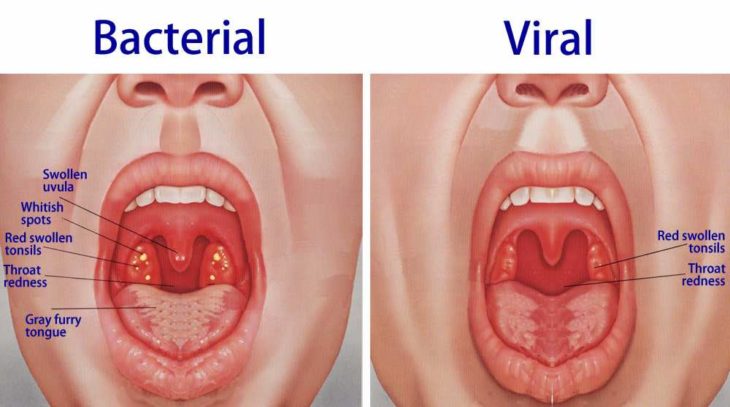Nowadays, swollen tonsils are a very common issue, but they are more than just a nuisance. As these oval mounds of tissue serve as a defense system, it’s crucial to know everything about them, including about bacterial throat infections and if tonsillitis is infectious.
Tonsils are the small oval mounds of flesh located on either side of the back of your throat. They have a crucial role in the body as they are the first lines of defense for our immune system. Hence, the task of the tonsils is to filter viral organisms and bacteria which enter the body through the nose or mouth.
However, tonsils aren’t immune to such bacterial and viral organisms and can become infected. Consequently, this leads to inflammation of the tonsils, known as tonsillitis. Vital organisms, such as flu and cold, are the ones that trigger tonsillitis and infections of the throat. However, it’s important to make a distinction between viral and bacterial infections as they aren’t addressed in the same way.
The pain at the back of the throat usually indicates that there is some type of infection present. Hence, this painful sensation can be caused by many environmental and behavioral factors, such as dryness in the air, cigarette smoke, mouth breathing, long periods of singing or talking, chemical cleaners, and allergy to dust or pollen.

Source: DrugsBank
Contents
Viral Throat Infection
If your throat feels irritated or scratchy it means that you have a sore throat and very likely the upcoming flu or cold. However, when the sore throat is triggered by such type of virus, it usually lasts shortly and gets replaced by other cold symptoms, including runny nose and cough. These two viral infections will usually resolve on their own and don’t require any medical intervention, but need rest and natural remedies. Thus, it’s crucial to know the difference between viral and bacterial throat infections.
So, if you are having a viral throat infection, you will probably experience at least one of the following symptoms, including hoarse voice, pain or a scratchy sensation in the back of the throat, swollen glands, and red tonsils with white spots.
Bacterial Throat Infections
Conversely, bacterial throat infections are a more serious matter and you need antibiotics to address them. The bacterial infections are most commonly caused by Streptococcus pyogenes, or group A streptococcus, which causes strep throat. Hence, if you had a fever in the last 24 hours and if you have a cough, there probably aren’t bacterial throat infections. Moreover, if the painful sensation is severe and lasts for longer, it usually means that you have a bacterial throat infection.
Tonsillitis

Source: Practo
Tonsillitis is an inflammation of the tonsil and they appear swollen, red or have white dots on them. Additionally, many people can experience staph infections in the throat. This inflammation and infections are triggered by staphylococcal bacteria that can live in your mouth or nose right now. Some people are constant carriers of this bacteria and at one point in life, it can enter the body and attacks the tonsils.
Strep Throat vs Tonsillitis
Besides the fact that many people have strep throat and tonsillitis at the same time, they aren’t the same infection. Strep throat can only be caused by Streptococcus, while the culprit of tonsillitis can be a number of different viruses or bacteria, including parainfluenza virus, adenovirus, herpes simplex virus, influenza virus, cytomegalovirus, and Epstein-Barr virus.
Is Tonsillitis Infectious?
You must be wondering if tonsillitis is infectious. Unfortunately, it is and can be spread by direct contact with an infected person. Hence, people who have tonsillitis usually cough or sneeze, which emits respiratory droplets in the air and affects the people nearby. So, if the culprit for tonsillitis is a viral infection, a person can be contagious for about 7-10 days. On the other hand, when the culprit is an untreated bacterial infection, a person can be contagious for up to two weeks. If the tonsillitis is caused by a bacterial infection, an individual will stop being contagious after taking antibiotics for about 24 hours.
So, if you have tonsillitis, you are likely to experience fever, sore throat, red and swollen tonsils, difficult or painful swallowing, hoarse voice, stiff neck, headache, bad breath, swollen glands in your neck, and stomachache.
It is very likely that viral tonsillitis will resolve on itself, while bacterial tonsillitis requires antibiotics. Hence, if you have noticed some of the symptoms of bacterial tonsillitis, you should contact your physician. According to yourdoctors.online, you should contact your doctor if you experience painful swallowing, difficulty breathing, drooling, extreme fatigue, and a sore throat that doesn’t go away within 24 to 48 hours.
In order to diagnose tonsillitis, your physician will check your throat and tonsils to look for signs of inflammation or infection. Moreover, they will probably examine the glands in your neck and jaw area to see if there are any signs of swelling. Then, they might also take a throat culture to check for signs of strep.

Source: Getty Images
Treatment of Viral Tonsillitis vs Bacterial Tonsillitis
Viral tonsillitis doesn’t require any medical intervention or antibiotics and will likely resolve on its own. However, you can help it resolve quicker by consuming warm liquids, get plenty of rest, enjoy popsicles, and take some mild over the counter pain relievers.
On the other hand, bacterial tonsillitis requires antibiotics to be treated. You are very likely to start feeling much better just in 24 hours after beginning antibiotics, but it’s crucial to finish your entire dose.
Preventive Steps for Tonsillitis
As prevention is the best medicine, you might want to undertake some preventive steps in order to prevent the spread of the illness. Thus, you should:
- never share drinks with other people
- always wash your hands with soap and water
- use a tissue or your arm when sneezing or coughing
- stay away from public places when your infection is contagious
- avoid touching your face with your hands
- take a zinc lozenge such as available at coldeeze.com
- consume a diet rich in vegetables and fruits
